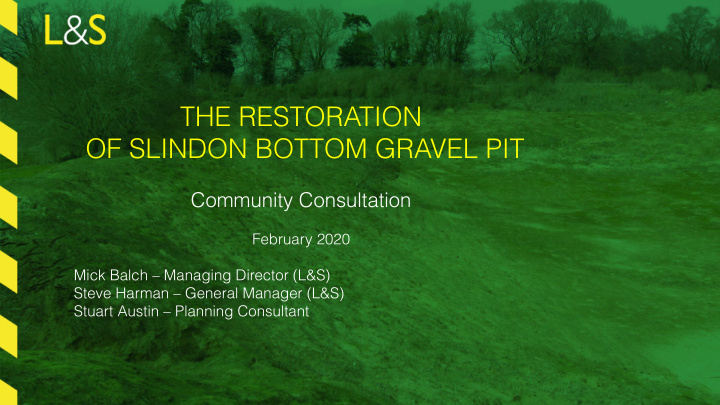



THE RESTORATION OF SLINDON BOTTOM GRAVEL PIT Community Consultation February 2020 Mick Balch – Managing Director (L&S) Steve Harman – General Manager (L&S) Stuart Austin – Planning Consultant
Introduction Site freehold owned by Slindon Bottom • Farm Ltd since 2008. L&S Waste Management operate from • bases in Southampton, Fareham, and Portsmouth. Employ over 150 staff and run a fleet of • 75 vehicles providing a range of waste services across Hampshire, Surrey and West Sussex and surrounding counties. Successful L&S in the Community Project • to help and support the wider community, including local people and charitable organisations.
Land Management Vulnerable to trespass and unauthorised activity. • Site subject to regular fly tipping. • Criminal damage including theft of weighbridge • plates. Used to store stolen property. • Landform attractive for unauthorised motor • sports. Measures in place to deter unauthorised entry • and use but difficult to police .
Site History Historic use for mineral extraction, waste disposal and • restoration which pre-dates the introduction of planning controls. Formal consents relating to these activities date back to • 1954, with subsequent permissions in 1960s, 70s, 80s and 90s. The older mineral workings, in the southern part of the • site, were backfilled by the local authority using household and general wastes prior to 1974. Later consents allowed for backfilling and restoration of • the northern workings with the use of inert material, with ancillary recycling. Principal activities ceased in late 1990s with the last • planning permission requiring the site to be restored in full by September 2006. Slindon Bottom Gravel Pit circa. 1940
Site History Backfilled land to South with historic restoration profile Lower level unrestored land to North markers
Recent History • After acquiring site in 2008 L&S sought permission to deliver previously uncompleted backfilling and restoration scheme, with separate application to re-start onsite recycling operation. • Site would have been restored to originally approved levels, with land returned to agricultural use, with some boundary tree and hedgerow planting. • No agreement reached with South Downs National Park Authority who had preference for minimal ‘low-level’ restoration scheme. SDNPA written advice provided October 2012. • In September 2016 old planning permission lapsed for all purposes. • In July 2019 South Downs Local Plan (2014 – 2033) formally adopted.
Restoration Solution • Seeking to develop a new restoration solution. • Key Objectives: • Fit with Vision and Policies of new South Downs Local Plan. • Engage Community in Design. • Be Deliverable.
Initial Concept South Downs Local Plan: • Landscape-Led Design • Enhance Natural Capital • Meet Policy Tests • Local Community: • Discussions held with nearest neighbours to site • Consultation with Local Parish Councils • Maintain engagement through all stages of Project • Delivery: • Requires viable engineering solution • Obtainable Environmental Permit • Be achievable within short timeframe •
Design – Landscape Led • Restoration of historic landscape features. • Reduction in height of final restoration levels and contour to fit within wider landscape. • Create inter-visibility and connection in the landscape with Public Right of Way Network. • Provision of land for pasture consistent with landscape character.
Design – Ecosystem Services • Woodland Planting – connectivity to off-site Ancient Woodland. • Reinstatement of Hedgerow Network to reflect historic alignment. • Creation of wetland habitat with species rich meadow and scrub. • Retained sand faces. • Provision of land for grazing.
Design – Community Effective use of onsite material to deliver early restoration • benefits and reduce volume of imported soils. Restrict principal restoration operations to central part of the • site – furthest away from residential properties and Public Right of Way. Provision of long-term access via Permissive Paths. • Use of Interpretation Boards – detail on site history / • biodiversity / landscape setting etc.
Design – Operational Delivery • Creation of single engineered restoration area centrally within site. • Maintains separation from historically tipped material. • Required volume for importation likely to be achieved in two year period. • HGVs to adhere to historic routeing agreement – via Britten’s Lane and Slindon Road.
What do we want to Achieve? “…a former part-restored mineral working that, to my mind, would benefit from being finished… • there must be a policy framework to allow a proposal to come forward…” Brian Cook, Planning Inspector (2014) Remove uncertainty for community, landowner, and planning authority. • Create a community asset with a long term beneficial use. • Provide a positive use for the land and bring an end to unauthorised uses. • Deliver long-term benefits that clearly outweigh any short-term disturbance from site operations. • Ensure scheme is designed and site is operated to ensure any short-term disturbance is minimised. •
Community Input • In principle support from nearest neighbours. • Seeking wider community input and support to shape final restoration scheme design. • Maximise value of resource to community – e.g. end uses / access. • Long term management.
Next Steps • Evaluate initial restoration concept design to incorporate first stage of community feedback. • Engage technical specialists i.e. ecologists and landscape architects to further influence final design to ensure natural capital benefits are fully maximised. • Undertake formal pre-application discussions with the South Downs NPA. • If in-principle support obtained move forward through planning process and re-consult with the local community before final submission.
Recommend
More recommend